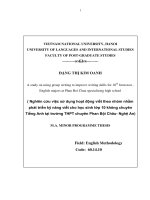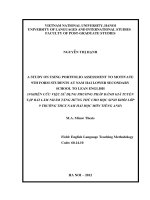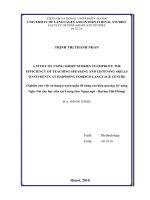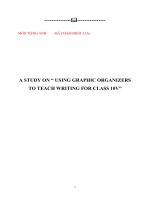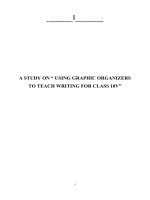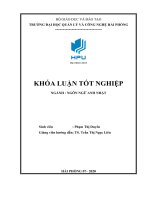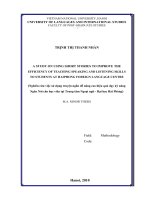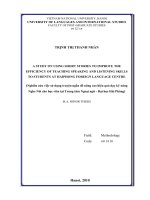A STUDY ON USING NARROW READING TO IMPROVE EFL learners reading fluency
Bạn đang xem bản rút gọn của tài liệu. Xem và tải ngay bản đầy đủ của tài liệu tại đây (557.75 KB, 93 trang )
MINISTRY OF EDUCATION AND TRAINING
VINH UNIVERSITY
HOANG THI ANH
THESIS: A STUDY ON USING NARROW READING TO IMPROVE EFL
LEARNERS’ READING FLUENCY
MAJOR: Teaching English to speakers of other language (TESOL)
CODE : 60140011
MASTER’S THESIS IN EDUCATION
SUPERVISOR:
Dr. TRAN THI NGOC YEN
NGHE AN, 2017
ABSTRACT
The purpose of this research is to examine the effect of narrow reading on
EFL learners’ reading fluency development. The survey was carried out
among 70 students at an upper secondary school in Nghe An, Viet Nam.
Before the treatment all participants did a general English test and 70
students who had similar results were chosen. They were divided into two
groups(control group and treatment group) and were asked to sit the pretest before participating in the narrow reading sessions. The post-test was
designed to see how fast the participants could read and how much they
comprehend. The collected data were analyzed in terms of reading speed
(words per minute) and reading comprehension (percentages). The results
showed significant differences between the experimental and control
groups in both aspects. The experimental group read with a higher speed,
and made bigger gains in comprehension compared with the control group.
This suggests that narrow reading has positive impacts on EFL learners'
reading fluency. Based on the findings, some implications for teaching
reading skill were proposed, limitations of the study were pointed out and
further research was suggested.
2
ACKNOWLEDGEMENTS
First of all, I would like to express my deep gratitude to Dr. Tran Thi Ngoc Yen,
my supervisor, who supported and encouraged me whenever I had problem with my
research. I am truly grateful to her for the valuable support, guidance, and constructive
comments she offered during the project time.
I wish to express my sincere thanks to the students of the two classes I worked
with in order to gather the data for my study.
I am also indebted to my friends for proofreading the first draft of the thesis.
Last but not least, I would like to express my special heartfelt appreciation
to my parents without whose unceasing sympathies and support my study
could not have been accomplished.
3
1. EFL: English as Foreign Language
2. ESL: English as Second Language
3. L2: Second language
4. L1: First language
5. FL: Foreign language
6. NR: Narrow reading
7. RC: Reading comprehension
8. WPM: Word per minute
comprehension for two groups at the post-test.
Table 4.7 Means and standard deviations of participants’ reading speed for two 45
groups at the first reading at the first week.
Table 4.8 Reading speed of Treatment group for four reading times at the first 45
week.
measured by words per minute for two groups at the third week.
Table 4.16 Reading speed of Treatment group for four reading times at the
51 third week.
comprehension for two groups at the first reading at the sixth week.
Table 4.30 Reading comprehension of Treatment group for four reading times 58 at
the sixth week.
Chart 4.1 : The class 10A2 general test result
37
Chart 4.2 : The class 10A3 general test result
37
Chart 4.3 Pre-test and Post-test reading speed (wpm) of control and
treatment 42 group
Chart 4.4 Pre-test and Post-test reading comprehension (%) of control and 44
treatment group
Recognizing letters and words is an important first step in learning to read.
However, it is only a first step; it is vital that students comprehend, or understand, what
they are reading. They must be able to get the meaning of the text: What is the author
telling the reader? That being said, reading comprehension is an essential skill for
success in school and in the real world. It is also worthy to note that readers find it
more difficult to read in another language.
1.1 Rationale
“Reading is an essential skill for ESL or EFL students; and for many skills, reading
is the most important skill to master” (Anderson, 1999). Krashen and Terrell (1989)
state that “reading is an important source of comprehensible input and can make a
significant contribution to competence in a foreign language.” Reading is considered as
one of the most essential skills which language learners should master, particularly
because it helps to build a variety of language expression and structures, broadens
general knowledge, increases levels of understanding and concentration and leads to
lifelong learning and improvement in the first and second language skills.
According to West (1941), reading ability is powerful because it transfers from one
language to another language. Therefore, if a person’s reading speed in his mother
language improves, it is likely that his foreign language reading rate will increase as a
transfer effect.
In the age of increasing global interconnectivity, it is essential for students to gain
foreign language proficiency. Hence, The Vietnamese Ministry of Education and
Training has put more emphasis on teaching and learning foreign languages, especially
English than ever before. Vietnamese students, nowadays, have been aware of the
importance of English and paid more attention to the subject. However, many of them
struggle with reading English texts. One of the reasons for this is that they lack the
necessary stock of vocabulary and knowledge of grammar rules.
Techniques and methods related to the teaching and learning foreign
language
have also been taken into consideration. A considerable number of studies in the
field of second language acquisition have been conducted over past years to examine
as well as help learners to improve reading speed and reading comprehension.
This study was carried out to explore the effects on narrow reading on
Vietnamese learners’ reading fluency development.
1.2 The aim of the study
The aim of this research is to demonstrate that reading speed and reading
comprehension of the EFL students will improve with consistent use of the narrow
reading method.
To be more specific, the study was set out to examine the EFL students’
development of reading speed and reading comprehension.
1.3 Research questions
The study aimed to seek the answer to the following questions:
1. Will narrow reading help to increase EFL learners’ reading speed?
2. How does narrow reading affect EFL learners’ reading comprehension?
1.4 Scope of the study
In this study, the participants’ reading fluency was measured by looking at
reading speed and reading comprehension. Reading speed was measured by
calculation the number of words read per minute. Reading comprehension was
measured by calculating the number of correct answers the participants had. Other
criteria of reading fluency was not taken into consideration in this study.
1.5 Design of the thesis
This research comprises five chapters as follow:
Chapter 1: Introduction - This chapter provides the rationale, the aim of the
study, the research questions and the scope of the study.
Chapter 2: Literature review - This chapter presents the previous studies
related to the topic of the thesis.
Chapter 3: Methodology - This chapter describes research methodology of the
study. It provides information about the participants, instruments, research
procedures and data analysis.
Chapter 4: Findings and discussion - This chapter presents the results and
discussions.
Chapter 5: Conclusion - This chapter summarizes the main findings and
conclusions, the limitations of the research and some suggestions for further studies.
Following the chapters are the references and appendices.
CHAPTER 2
LITERATURE REVIEW
This chapter presents a brief review of the literature on the topics that are
generally related to the research in this thesis. Previous studies on the reading
process, reading fluency, reading comprehension, reading speed, narrow reading and
narrow reading in EFL teaching instruction will be mentioned.
2.1 The reading process
According to Anderson (2003), reading is a constant process of guessing,
predicting, checking, and asking oneself questions. Reading is one of an essential
skill to master in learning English. For most learners, reading is the most important
skill to master in order to ensure success in learning English. Students tend to make a
good progress in other area of language learning if they master reading.
Reading is a completely individual activity which takes place in all different
ways from newspapers, magazines, written texts, etc. Understanding the process of
reading is probably important to understanding of its nature. Therefore, “Reading is
an exercise dominated by the eyes and the brain. The eyes receive message and the
brain then has to work out the significance of the message” (Harmer J, 1989, p. 190).
Thus the speed of reading depends much on mechanical process of looking and
perceiving and it is the reader who decides how fast he wants to read the text.
2.1.1.
The definitions of reading
So far, the term reading has been defined quite differently according to its
various aspects such as criteria, features and functions. For many learners, reading is
a very essential skill, particularly in English as a second language. Concerning the
role of reading, Carrell (1988, p.1) states that “Without solid reading proficiency,
second language learners can not perform at levels they must in order to succeed".
Anderson, (1999) also confirms that “The more exposure a student has to language
through reading, the greater the possibilities that overall language proficiency will
increase”. Reading plays such a significant part in the success of second language
learning and it is essential to understand what reading really is. However, the act of
reading is neither completely understood nor easily described. In a general term,
reading is defined as “An active, fluent process which involves the reader and the
reading material in building meaning" (Anderson, 1999, p.1). This definition of
reading has been generally shared by other researchers.
According to Aebersold and Field (1997), “reading is what happens when
people look at a text and assign meaning to the written symbol in that text. The text
and the reader are the two physical entities necessary for the reading process to
start. It is, however, the interaction between the text and the reader that constitutes
actual meaning" (p.15). These interactions, in their opinion, are the interactions
between purpose and manner of reading and through reading strategies and schema.
Purpose determines how people read a text. People may read the text to understand it
(reading for full comprehension), or simply to get the general idea (skimming), to
find the part that contains the information they need (scanning). Readers also use
some mental activities that are often referred to as reading strategies to construct
meaning from a text. In addition, readers base on their previous knowledge that they
bring to the text to assist their reading comprehension. This prior knowledge is
known as schema. Research in reading has shown that schema plays an important
role in helping the reader to comprehend a text.
Moreover, Rubin, J and Thompson, I (1994, p. 91) offer another definition of
reading: “Reading is an active information-seeking process in which readers relate
information in the text to what they already know”. From this point of view, the
reader’s knowledge of the language and knowledge of the world is of importance to
their reading success. Goodman (1971, p. 135) states that reading is “a
psycholinguistic process by which the reader- a language user, reconstructs, as best
as he can, a message which has been encoded by a writer as a graphic display". For
Goodman, this act of reconstruction is considered as cyclical process of sampling,
predicting, testing and confirming.
Walker (1992, p. 37) defined reading as an active, problem solving process that
involves predicting or guessing what the author says, based on expectations about
story events. He believes that reading involves recalling an individual’s life
experience and trying to understand what is written. He also confirms that reading is
comprehending and developing of human learning. In other words, reading is more
than just receiving meaning in a literal sense.
From a cognitive attitude, Smith (1985, p. 102) defines reading that “Reading
is to understand author’s thought”. This means that the meaning of the text depends
on the context in which appears. The more the reader conceive the author’s thought,
the more he is aware of the writer’s intention.
Taking an interactive attitude, Nutall (1982, p. 4) expresses “Reading means
getting out of the text as nearly as possible the message the writer puts into it”. He
also emphasizes the interaction between texts and readers in the reading process. In
his opinion, “Text is full of meaning like a jug of water, the reader’s mind soaks it up
like sponge”.
2.1.2.
The role of reading in learning
Reading plays an inevitably important role in comprehending a text and using
the foreign language appropriately and fluently. “A person’s future opportunities for
success and prosperity will be even more entwined with skill reading abilities. It is
therefore an important societal responsibility to offer every person the opportunity to
become a skilled reader, and in many cases, this means becoming a skilled L2
readef" (Grabe, 2009, p. 6).
It is possible for us to claim that reading has a very important role to play in
language learning as it can bring benefits to learners. William (1984, p. 13) suggests
three advantages of reading to learners: First, learners can have further practice in the
language that they have learnt. This means that learners will have many opportunities
to gain further knowledge of the target language. Second, learners can practice
language in order to reuse it in other skills such as speaking and writing. Learners
can not understand anything if they can not read. Third, learners can learn how to get
benefit from the texts to extract the information they need. The more comprehension
learners conceive, the more major intelligence they receive.
Reading has a large number of major benefits that help learners study language
faster and more successfully. Reading is one of the most essential skills for language
learners. When learners’ reading skill improve, their listening, speaking, and writing
also advance. There are some specific reasons why learners are encouraged to
practice reading. In the first place, the constant repetition of words and patterns in
reading helps you learn and remember vocabulary and grammar structures. Reading
plays an important part in providing vocabulary and structure types. Learners can
understand the usage of structures better when they catch the meaning of sentences.
Secondly, reading is something readers can do their own. Learners can spend as
much time as they wish on reading by themselves. Language learners are able to
practice reading skill whenever they want. The skill does not extremely depend on
others.
2.2 The reading fluency
Reading fluency is a topic that has received considerable attention in recent
years. As a result of the renewed interest in this topic, the lack of agreement on what
reading fluency actually is has been brought to the forefront. Reading fluency is
often defined as accurate reading of connected text at a conversational rate with
appropriate prosody (Armbruster, Lehr, & Osborn, 2001; Hudson, Lane, & Pullen,
2005; National Reading Panel, 2000) and is often measured as a combination of rate
and accuracy - the number of correct words read aloud in one minute (Fuchs, Fuchs,
& Maxwell, 1988; Shinn, Good, Knutson, Tilly, & Collins, 1992; Torgesen, Rashotte,
& Alexander, 2001). Daane, Campbell, Grigg, Goodman, and Oranje (2005) define
fluency “in terms of phrasing, adherence to the author’s syntax, and expressiveness”
in other words, prosody. Taking a slightly different stance, Samuels (2006, p. 39)
defined reading fluency as “decoding and comprehending at the same time” and
suggested that rate, accuracy, and prosody are indicators that this is happening.
The variability in these definitions reminds us that reading fluency is a
complex, multifaceted construct. In theory, because reading fluency is typically
assessed while students are reading meaningful text, one’s definition of fluency
might easily encompass all that is important about “proficient reading": it is accurate
and efficient, it occurs with reasonable speed that varies with the text, and it involves
good comprehension of the meaning of the text. The definitions outlined above differ
in the extent to which they emphasize one or more of the dimensions of what is
typically meant by proficient reading of text. The definition offered by Daane et al.
(2005) emphasizes comprehension as the most important part of the definition of
reading fluency (because prosody of oral reading reflects comprehension), while the
operational definition often used in studies of oral reading fluency (Fuchs et al.,
1988) emphasizes accuracy and rate of reading. Samuel’s definition (2006) is
actually theoretically driven, as his earlier work (LaBerge & Samuels, 1974) implies
that decoding and comprehension are most able to occur together when parts of both
speed and comprehension are most able to occur together when parts of both
processes operate “automatically.” Rate is one dimension of automaticity; suggesting
that decoding and comprehension must occur together in fluent reading is to imply
that decoding, or word identification, is occurring at a reasonable rate.
When thinking about the components of a definition of reading fluency, we
are reminded of this statement by Wolf and Katzir-Cohen (2001, p. 220):
The unsettling conclusion is that reading fluency involves every process and
sub skill involved in reading....Unlike reading accuracy, which can be
executed without utilizing some important reading components like semantic
processes, we argue that fluency is influenced by the development of rapid
rates ofprocessing in all the components of reading.
Fuchs, Fuchs, Hosp and Jenkins (2001) add to this emphasis on complexity:
Oral reading fluency represents a complicated, multifaceted performance that
entails, for example, a reader’s perceptual skill at automatically translating
letters into coherent sound representations, unitizing those sound components
into
recognizable
wholes,
and
automatically
accessing
lexical
representations, processing meaningful connections within and between
sentences, relating text meaning to prior information, and making inferences
to supply missing information. (p, 239-240)
These researchers, along with Adams (1990), Ehri (1998), Laberge and Samuels
(1974), were among the first to unpack reading fluency by examining the various
processes, skills, and knowledge needed to read fluently. It is gainful in their efforts
to discern the multifaceted nature of the construct in order to better understand how
to assess and teach reading fluency.
2.2.1
The indicators of reading fluency
Though researchers approach reading fluency from different perspectives, a
consensus on the indicators of reading fluency has been established. There is popular
agreement that automaticity, accuracy, and reading speed (for silent reading) or
prosody (for oral reading) are the three fundamental indicators (Grabe, 2004b; Harris
& Hodges, 1995; Kuhn & Stahl, 2003; LaBerge & Samuels, 1974b; Rasinski, et al.,
2006; Richards, 2000; Tompkins, 2003; Worthy & Broaddus, 20012002).
Automaticity is defined as fast, accurate and effortless word identification at
the single word level. The speed and accuracy at which single words are identified is
the best predictor of comprehension. Fluency, on the other hand, involves not only
automatic word identification but also the application of appropriate prosodic
features (rhythm, intonation, and phrasing) at the phrase, sentence, and text levels.
Wood, Flowers, and Grigorenko (2001) emphasize that fluency also involves
anticipation of what will come next in the text and that speeded practice alone is not
sufficient. Anticipation facilitates reaction time and is particularly important for
comprehension.
2.2.2
Assessing reading fluency development
The ability to measure students’ level of achievement in fluency and monitor
their progress is key to successful fluency teaching. Teachers need to be able to
gauge the effectiveness of their instruction in fluency; to do this, they need ways to
assess student fluency validly and efficiently. Although the theories of reading
fluency indicators have won general acceptance, there is still much controversy
relating to how to assess fluency development.
A Past research has used a technique in which a phrase extracted from a book
was exposed to students for a limited period of time and then students had to say the
phrase (Huey, 1968). Another method involves small passages from an original story
to measure children’s oral fluency. The passages were read aloud by the teacher and
the students relayed these back to their teacher to record. The method of repeating
was afterwards put onto computers so that students could test themselves by first
having the computer determine their zone of reading ability; second, selecting the
graded passages which increase in difficulty; third, listening to a model reading
already made and saved on the computer, then silently reading the passage they
chose. The computer sets the target and calculates if the student has reached it or not
(LaBerge & Samuels, 1974b). Several studies also applied the curriculum-based
measurement (Deno, 1985) to assess L1 oral reading fluency. This is a general
outcomes measure of a student’s performance in reading, writing, and spelling. In
reading, accuracy is determined by dividing the number of words read correctly per
minute by the total number of words read and comparing the students’ performance
against the target rate norms. Meanwhile the rate is measured by calculating the total
number of words read correctly per minute and comparing the students’ performance
against the target rate norms.
Recent developments in teaching and learning the reading skill have
heightened the need for measuring silent reading fluency. As a result, researchers
have attempted to formulate methods to measure reading rate and comprehension
both for L1 silent reading (Juel & Holmes, 1981; Mead, 1917; Vacca & Vacca, 1999)
and L2/FL silent reading (Bismoko & Nation, 1972; 1974; Chung & Nation, 2006;
Cramer, 1975; Gorsuch & Taguchi, 2008). Regarding reading speed, which is
conventionally measured by the words per minute calculation, the one-minute
reading probe and the entire text method have been used in both L1 reading research
(Harris & Sipay, 1985; Ream, 1977; Rial, 1977) and L2/FL reading research
(Iwahori, 2008; Lai, 1993; Taguchi, et al., 2004). Particularly in L2/FL research, the
three-minute probe and the ten-second interval method have been used (Bell, 2001;
Macalister, 2008; Millett, 2005b, 2005d; Millett, et al., 2007; Nuttall, 1982; Sheu,
2003). With respect to comprehension assessment, the most popular methods to
measure comprehension are true-false questions, multiple choice questions, short
answer questions, recall tests and participant self-reports (Alderson, 1990; Gorsuch
& Taguchi, 2008; Iwahori, 2008; Lai, 1993; Paretz & Shoham, 1990; Taguchi, et al.,
2006). Typically, in a speed reading course, the learners are asked to keep a graph of
their speed in words read per minute and a graph of their comprehension score on the
accompanying questions. In this way, the teacher can see students’ progress in
reading speed and at the same time be informed about their comprehension level
(Macalister, 2008; Millett, et al., 2007; Quinn & Nation, 1974).
2.2.3
First and second language reading fluency
A number of studies have been carried out on first and second language
reading fluency. According to West (1941), reading ability transfers from one
language to another language. Therefore, if people’s reading speeds in L1 improve, it
is likely that their L2 reading rate will increase as a transfer effect or L1 reading is a
dominant variable in L2 reading performance (Bossers, 1992; Brisbois, 1995;
Carrell, 1991; Hacquebord, 1999; Roller, 1988). Researchers have also proposed the
short-circuit hypothesis, also known as the language threshold hypothesis, which
holds that learners have to reach a certain level in L2 knowledge in order to transfer
their L1 reading ability to L2 reading (Clarke, 1979; Clarke, 1980) or attempted to
determine the link between word recognition and comprehension in L2 reading
(Levy, Abello, & Kysynchuk, 1997). Besides, past research also found that not only
L1 strategies transfer to reading L2 texts (Seng & Hashim, 2006), but also attitudes
gain more confidence in L2 reading (Yamashita, 2004).
There, recently, has been an emerging body of literature on the relationship
between L1 reading and L2 reading development. Some of those studies reported a
relationship between L1 reading and L2 reading in which L2 knowledge accounted
for more than 30% of the variance in L2 reading performance whereas L1 reading
ability accounted only for just over 10% of the variance in L2 reading scores
(Bernhardt & Kamil, 1995).
2.3 Reading comprehension
Reading comprehension plays an important role in teaching and learning
reading a foreign language. It has the nature of communication, in which reading
activity acts as a means of communication between the writer and the reader.
Reading comprehension can be affected by word knowledge, with many
demonstrations that readers who process rich prior knowledge about the topic of
reading of understand the reading better than others with low prior knowledge.
2.3.1
Comprehension and reading comprehension
According to interactive model of reading, comprehension is built up or
constructed from knowledge sources which interact with each other on the input
from the written page. Anderson and Pearson (1984, p. 225) argue that when students
make a critical evaluation of the ideas conveyed in the text: “they are making
connection between the new information on the printed page and their existing
knowledge.”
Numerous studies have explored the nature of comprehension in reading. Smith
(1978) considers it as a state of having questions answered in which readers have to
find a configuration of hypotheses which offer a coherent account for the various
aspects of the text (Rumelhart, 1977). Calfee and Curley (1984) show that readers
modify the organizational structure of the texts for their own purposes in order to
comprehend a text. While reading, they keep making predictions or questions based
on their theories about the world, and if the questions are answered while or after
reading, comprehension is achieved (Smith, 1978).
Lee and Vanpatten (1995, p. 191) indicate that comprehension is the process of
relating new or incoming information to information already stored in memory.
Readers make connections between the new information on the printed page and
their existing knowledge. They must allow the new information to enter and become
a part of their knowledge store.
If reading is simple mechanical movements of the eyes, reading
comprehension includes mechanical and mental activities. In teaching reading, it is
necessary for both teachers and students to have a deep understanding about the
definition of reading comprehension. The students who study reading should
evaluate continually what they are learning about the definition of reading
comprehension. Many people have done some researches to define what reading
comprehension is.
Reading comprehension takes a very important part teaching and learning
reading a language as well as a foreign language. According to Durkin (1993)
reading comprehension is “intentional thinking during which meaning is constructed
through interactions between text and reader.” It is the capacity to get information
from the text as efficiency as possible. This agrees with Grellet (1981, p. 34)’s
definition, which says that “reading comprehension or understanding a written text
means extracting the required information from it as effectively as possible”. From
this point of view, Grellet focuses on readers’ ability of understanding the meaning of
a written text based on the individual’s background knowledge. Alon similar lines,
Swan (1975, p. 1) states that “a student is good at comprehension we mean that he
can read accurately and efficiency, so as to get the maximum information of a text
with the minimum of understanding.” This means that the student can excess his
awareness by re-expressing the content of the text in many ways such as
summarizing the text, answering question, etc. After reading, readers can master the
grammatical structures, word pronunciation, understand the context of the texts and
use it in real life as effective as possible.
Richards and Rodgers (1986, p. 7) assert reading comprehension is “the
understanding between the author and the reader”. This means that during the
reading process, readers on the way to explore what the author implies and to raise
meaning for themselves at the same time in their own language, their thinking and
the own view of the world depended on their background knowledge. It is not easy to
understand the author’s meaning fully if there is no good interaction between the
author and reader about language and thought. Therefore, the reader is as active in
searching for meaning as is the writer in forming written language. Although
linguists defined reading comprehension in different ways, they all agree with the
idea that without comprehension reading is meaningless.
Reading comprehension plays a very important part in teaching and learning a
foreign language in general and teaching reading in particular. However, the reasons
for reading differ from one person to another. As a result, the ways we read are also
different. In other words, the purposes of reading determine the ways or the styles of
reading.
2.3.2
Factors involved in reading comprehension
Researchers have proposed various factors affecting reading. According to
Aebersold and Field (1997, p. 23), there are some following factors involved in
reading comprehension. Firstly, cognitive development and cognitive style
orientation at the time of beginning second language or foreign language study.
Secondly, language proficiency in the first language. Thirdly, precognitive
knowledge of L1 structure, grammar, and syntax. Fourthly, degree of difference
between the L1 and L2/ FL that includes writing systems, rhetorical structures,
appropriate strategies. Fifthly, cultural orientation which includes attitudes toward
text and purpose for reading; types of reading skills and strategies used or
appropriate in the L2/ FL; belief about the reading process (use of inference,
memorization, nature of comprehension); knowledge of text types in the L1 (formal
schemata); background knowledge (content schemata).
Language proficiency in L2 and background knowledge are two factors which
affect RC the most because if readers apply their background knowledge to texts in
order to read and understand them. If readers possess good at language capability, it
will be much more convenient for them to apprehend and acquire L2 purposes they
are studying. Therefore, to help students able to read texts or materials in their
learning programmer perfectly, it is advisable for teachers to identify the students’
level of language proficiency and how they understand the required texts. This means
teachers should choose suitable texts to ask learners to read carefully. Furthermore,
teachers should be aware of the rest factors affecting reading skills to help the
students to the maximum. Especially, teachers should motivate their students by
providing them with as many reading strategies as possible and know how to focus
them on appropriate texts when practicing and try to decline the difference as well as
the difficulty between target and native language.
Reading comprehension is a cognitive process that requires myriad, skills and
strategies. It involves various factors such as background knowledge, vocabulary and
fluency, attention and motivation, and quality of reading material that must work
together.
Firstly, background knowledge plays an essential role in RC. Students effort to
apprehend a text, students depend on their background knowledge to link what they
have already known to the meaning of the text they are reading. The influential role
of background knowledge on RC is actually unveiled as early as children’s beginning
years. Bauer and Fivush (1992; in Pressley, 2000, p. 549) determine that even very
young children develop schematic representation for repeated events in their lives
such as having dinner at home or at a restaurant, celebrating birthday, making cakes,
etc. Such knowledge enables them to draw inferences from bedtime stories relying
on information accumulated in their schemata. Therefore, the more abundant the
knowledge a child acquires form outside world through experiences and from stories
or newspapers, the larger his schematic knowledge tends to be, and the more
successful will be his processing of text when he reads.
Secondly, the decoding and word recognition speed are two cognitive factors
that can affect RC at which readers decodes and recognizes words. Decoding refers
to the readers’ ability to make sense of letter-sound relationships, including proper
word pronunciation and noticing common letter combinations, in order to quickly
recognize familiar words. According to Pressley (2000), if the reader is not able to
decode, his comprehension will be impaired skilled decoders do not sound unfamiliar
word letter by letter, they are rather able to recognize suffixes, prefixes, Lation or
Greek roots, ect. Decoding is a set of fundamental skills that underlies all successful
reading. Readers who experience difficulty with decoding and recognizing words
read at a much slower pace and find it more difficult to apprehend the meaning of
reading passages than their peers without decoding difficulties.
Thirdly, vocabulary can also have an impact on reading comprehension.
Experiments have found out that “a more expensive vocabulary promotes
comprehension skills” (Pressley, 2000, p. 548). However, as skilled decoding has a
tendency to affect RC, it also relies much on understanding. This means, the more
fluency letters are linked to their sounds, the less conscious effort is required for this,
and the more capacity is left over for comprehension of words. Readers use decoding
skills to figure out the pronunciation.
Meaning of words they have not seen before, but this process takes far more
time than recognition of a familiar word: individuals with a wider vocabulary can
interpret the meaning of reading passages faster and more thoroughly than
individuals who must guess at the meanings of unfamiliar words based on context
clues.
Fourthly, fluency of reading allows students to retain information with
accuracy, expression and increased speed. The capacity to read fluently develop
through reading practice. As learners become fluent readers, they will spend less time
trying to decipher the meaning of words and more time considering the overall
meaning of the sentences. Over time, fluent readers will strengthen their ability to
insightfully respond to a text.
Fifthly, reader’s attention and motivation are integral to reading
comprehension. A reader whose attention is only partly on the reading passage may
read the same paragraph several times without understanding what he is reading.
Readers who lack motivation to penetrate the text may do the bare minimum of
reading and understanding necessary for their assignment or class discussion without
fully absorbing or interpreting the meaning of what they have read.
Finally, the quality of writing can also affect reading comprehension. Text that
is poorly organized and difficult to understand can slow reading speed and
significantly hinder RC. Poor quality writing may slow decoding comprehension.
Poor quality reading material can also cause the readers to lose motivation while
reading, which negatively affects the reader’s comprehension of the text.
2.3.3
Assessing reading comprehension
Accurate assessment of reading comprehension is necessary to know if this
goal is being met, to identify learners who needs remediation, and to help plan future
instrument.
Reading comprehension can be assessed by means of different procedures,
however, none of which can be elected as the best process or the most suitable one.
This is because no procedure is able to encompass all testing purposes (Alderson,
2000, p. 203). According to Alderson (2000, p. 205-206), testers can use many
typologies to measure learners’ reading: multiple choice questions, short-answer
questions, sentence completion, completing summaries and tables, identifying
writer’s views and attitudes by yes/ no questions, matching lists and matching
phrases. The following is a brief discussion of what each assessment method entails
according to Alderson (2000).
As stated by Alderson (2000), multiple-choice technique is one of the most
popular methods for assessing test taker’s passage understanding. In fact, it is the
most spread way to test reading with two, three, four or more alternatives. This
technique can be used frequently in reading textbooks because of its common usage.
According to Hughes (2003), the test taker supplies indication of reading success by
selecting one out of a number of choices. Alderson (2000) also said that this
technique enables test constructors to check the selection of probable responds to
comprehension questions and in some degree to check the test taker’s thinking step
when they answer. Multiple choice questions technique is a well known procedure
for assessing reader’s text processing abilities. To answer multiple choice question
technique, students can only make resource to their past experience, knowledge and
logical thinking.
Additionally, the cloze procedure was widely used during the 1970’s as an
assessment tool of both language and reading abilities. Aitken (1977) defines cloze
test as “a type of fill-in-the blank test” which is designed by randomly removing
words from a prose passage and replacing them with gaps. In other words, it
resembles “fill in the blank” exercises. Its construction is similar with lose test in
some aspects. It is also defined by Alderson (2000) as a test which is not designed
according to pseudo-random procedure and in which the number of words which is
between deleted words is maximally five or six. Furthermore, Weir (2005) explains
this assessing technique as a test in which content words are removed from the
passage and test takers have to find the correct word for every gap.
Alderson (2000, p. 215) notes that matching technique can be defined as a test
in which “two sets of stimuli” have to be paired against each other. He exemplifies
this technique with “matching headings for paragraphs to their corresponding
paragraph and titles of books against extracts from each book”. In this type of tests,
students are required to match a number of items that combines well with some
others. For instance, to link titles or main ideas with their relevant paragraph.
Specially, more items than needed for the matching activity to make sure that
learners’ choices are made after alternative processing (Alderson, 2000, p. 219).
Ordering task is explained by Alderson (2000) that is a mixed group of words,
sentences, paragraphs or passages is provided to the test takers and these words or
phrases, etc are placed into the correct order by the test takers. Comprehending text
completely is significant to order the items correctly. He points out that even if
ordering tasks are charming in the aspect of tester because of accessing the ability to
find cohesion, complete passage, or grammar. Ordering task is one of the hardest
tests to design and establish.
Alderson (2000, p. 222) considers true/ false question as a test in which the test
takers are given with an explanation which is relevant with a target passage and they
have to show “whether this is true or false, or whether the text agrees or disagrees
with the statement". Alderson also points out that the technique in common since it is
constructed easily. Infect, this is an easy test to create. True/ false questions
technique involves students in selecting one item out of two to provide answers to
